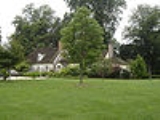
Wye House
Encyclopedia

Plantation
A plantation is a long artificially established forest, farm or estate, where crops are grown for sale, often in distant markets rather than for local on-site consumption...
house located in Talbot County, Maryland
Talbot County, Maryland
-2010:Whereas according to the 2010 U.S. Census Bureau:*81.4% White*12.8% Black*0.2% Native American*1.2% Asian*0.1% Native Hawaiian or Pacific Islander*1.6% Two or more races*2.7% Other races*5.5% Hispanic or Latino -2000:...
, seven miles (11 km) northwest of Easton
Easton, Maryland
Easton, founded 1710, is a town within the Easton District of Talbot County, Maryland, United States. The population was 11,708 at the 2000 census, and 14,677 according to current July 2008 census estimates. It is the county seat of Talbot County. The primary ZIP Code is 21601, and the...
. It was listed for preservation on the National Register of Historic Places
National Register of Historic Places
The National Register of Historic Places is the United States government's official list of districts, sites, buildings, structures, and objects deemed worthy of preservation...
in 1970.
History
The Wye plantation was settled in the 1650s by a WelshWales
Wales is a country that is part of the United Kingdom and the island of Great Britain, bordered by England to its east and the Atlantic Ocean and Irish Sea to its west. It has a population of three million, and a total area of 20,779 km²...
Puritan
Puritan
The Puritans were a significant grouping of English Protestants in the 16th and 17th centuries. Puritanism in this sense was founded by some Marian exiles from the clergy shortly after the accession of Elizabeth I of England in 1558, as an activist movement within the Church of England...
and wealthy planter, Edward Lloyd. Between 1780 and 1790, the main house was built by his great-great-grandson, Edward Lloyd IV
Edward Lloyd (delegate)
Edward Lloyd IV was an American planter from Talbot County, Maryland. He was a delegate to the Continental Congress for Maryland in 1783 and 1784. In 1771 Lloyd purchased the Chase-Lloyd House in Annapolis, Maryland from Samuel Chase, and in 1790 he built Wye House on the family plantation at Wye...
. It is cited as an example between the transition of Georgian
Georgian architecture
Georgian architecture is the name given in most English-speaking countries to the set of architectural styles current between 1720 and 1840. It is eponymous for the first four British monarchs of the House of Hanover—George I of Great Britain, George II of Great Britain, George III of the United...
and Federal architecture
Federal architecture
Federal-style architecture is the name for the classicizing architecture built in the United States between c. 1780 and 1830, and particularly from 1785 to 1815. This style shares its name with its era, the Federal Period. The name Federal style is also used in association with furniture design...
, which is attributed to builder Robert Key. Nearby the house is an orangery
Orangery
An orangery was a building in the grounds of fashionable residences from the 17th to the 19th centuries and given a classicising architectural form. The orangery was similar to a greenhouse or conservatory...
, a rare survival of an early garden structure where orange and lemon trees were cultivated, and which still contains its original 18th century heating system of hot air ducts.
During its peak, the plantation surrounding the house encompassed 42000 acres (16,996.8 ha) and housed over 1,000 slaves. Though the land has shrunk to 1300 acres (526.1 ha) today, it is still owned by the descendants of Edward Lloyd, now in their 11th generation on the property. Frederick Douglass
Frederick Douglass
Frederick Douglass was an American social reformer, orator, writer and statesman. After escaping from slavery, he became a leader of the abolitionist movement, gaining note for his dazzling oratory and incisive antislavery writing...
spent a few years of his life on the plantation, around the ages of seven and eight, and spoke extensively of the brutal conditions of the plantation in his autobiography, Narrative of the Life of Frederick Douglass, an American Slave
Narrative of the Life of Frederick Douglass, an American Slave
Narrative of the Life of Frederick Douglass is a memoir and treatise on abolition written by famous orator and ex-slave, Frederick Douglass. It is generally held to be the most famous of a number of narratives written by former slaves during the same period...
.
Modern situation
The nearby hamlets of Unionville and Coppertown are where many descendents of the slaves who worked Wye House live today. This has created an interesting dynamic, considering the descendents of both the slave owners and the slaves still live within a very short distance of one another.The Wye House plantation gained significant media attention in 2006 for archaeological investigations led by the University of Maryland
University of Maryland, College Park
The University of Maryland, College Park is a top-ranked public research university located in the city of College Park in Prince George's County, Maryland, just outside Washington, D.C...
.
In 2011, excavation of the greenhouse, built by African slaves, brought a discovery of African charms laid to ward off bad spirits at the house's furnace and entrance.
See also
- Chase-Lloyd HouseChase-Lloyd HouseThe Chase-Lloyd House in Annapolis, Maryland is a brick three-story Georgian mansion dating from 1769-1774 with interiors by William Buckland . Its construction was started for Samuel Chase, who would later be a signatory to the Declaration of Independence and Associate Justice of the Supreme...
National Historic Landmark in Accident, MarylandAccident, MarylandAccident is a town in Garrett County, Maryland, United States. The population was 353 at the 2000 census. The town is home to Northern Garrett High School...
, owned by the Lloyd family 1771-1847.

